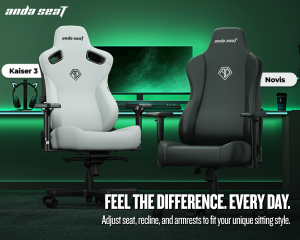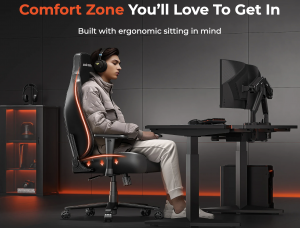
AndaSeat Highlights Ergonomic Versatility with May 2025 Focus on Kaiser 3 and Novis Series Seating Platforms
AndaSeat Highlights Ergonomic Versatility with May 2025 Focus on Kaiser 3 and Novis Series Seating Platforms
SPOKANE, WA, UNITED STATES, May 18, 2025 /EINPresswire.com/ -- With increasing variation in how individuals structure their home and workspace routines, AndaSeat is publishing an overview of two of its current seating platforms—Kaiser 3 and the Novis Series—to illustrate the evolving function of task chairs across multiple usage environments. This reflection coincides with ongoing changes in global work-leisure habits, including longer seated periods and the growing overlap between recreational and professional spaces.
The product architectures of Kaiser 3 and Novis, though developed at different ends of AndaSeat’s catalog, reflect shared structural goals: durable support, ergonomic consistency, and mechanical reliability during prolonged seated activity. Neither product is newly introduced, but both have seen extended relevance due to postural health trends across users of different profiles.
Ergonomics Under Daily Demand: Long-Hour Seating and Posture Concerns
As extended seated time becomes routine for workers, students, and recreational users alike, questions about lumbar integrity, pressure management, and long-term spinal stress have drawn new attention to seating design. Global health organizations and occupational studies continue to document the effects of inadequate lower back support, muscle fatigue, and postural rigidity, particularly in environments lacking dedicated seating infrastructure.
AndaSeat’s Kaiser 3 and Novis Series offer two structurally different approaches to these shared ergonomic concerns: one through adjustable modular systems, and the other through fixed passive support components. Both are in continuous use in diverse contexts, including individual workstations, shared home environments, and hybrid desk setups.
Kaiser 3: Configurable Systems for High-Duration Use
The Kaiser 3 platform features a four-way built-in lumbar system designed to match the lower spine's curvature with adjustable support parameters. With 76mm of vertical travel and 30mm of depth tuning, the backrest structure allows for seated pressure to be distributed along the thoracolumbar region during recline or upright positioning.
The chair uses cold-cure foam of high density, engineered to retain its form and support profile over time. Combined with a tilt mechanism offering up to 155° recline and 15° rocking mode, Kaiser 3 allows users to maintain variable postures throughout the day.
Material options include DuraXtra™ synthetic leather and 3D breathable linen. These are tested for abrasion resistance, moisture response, and long-term shape retention. Both options are available in multiple colors. Armrests operate on a four-dimensional adjustment axis and are supported by the MagSwap™ magnetic replacement system.
The structural components—SGS-certified gas lift, cast aluminum base, and polyurethane-coated wheels—undergo routine testing for load capacity and movement fluidity. Two size profiles are manufactured to support users between approximately 150 and 203 cm in height.
Novis Series: Passive Structural Support for Standard Workloads
In contrast to adjustable lumbar configurations, the Novis Series incorporates a raised lumbar form into the backrest, elevated 5cm forward from the seat plane. This element does not require user input and is intended to offer automatic lower-back contact during general use.
Cold-cure foam is also employed in the Novis seating surface, calibrated at a density of 60kg/m³. This formulation aims to prevent flattening and provide even body-weight distribution across sitting durations.
The base seat features elevated side contours (5cm) that guide the user’s legs into a centered alignment and reduce sliding. These contours may assist users who frequently change posture during seated periods.
Adjustments include backrest recline up to 155°, 10cm of height variability, and 7cm of vertical armrest movement. Armrests are reinforced by iron columns. Both Novis L and XL sizes include a rocking feature and are offered in PVC leather or linen upholstery. The chairs are designed to accommodate users ranging in height from approximately 155 to 210 cm and up to 120 kg in weight.
Optional accessories—such as memory foam head and lumbar pillows—are available for further positional support but are not integrated into the standard structure.
A Comparative View of Support Approaches
While the Kaiser 3 and Novis Series share common material types and general form factors, their designs prioritize different use patterns.
Kaiser 3 employs a configurable support strategy, better suited for users who adjust their seat frequently or alternate between high-focus and low-focus tasks.
Novis delivers a simplified configuration where support is embedded passively into the frame, requiring minimal interaction from the user.
Neither chair requires external support accessories by default, and both are produced with emphasis on frame integrity, resistance to surface wear, and adaptability across common floor types.
These two models illustrate how different ergonomic approaches can meet varying demands—not only for traditional gamers or office workers, but also for remote students, shared households, and flexible workstation setups.
Broader Trends and AndaSeat's Position
AndaSeat continues to monitor the changing definitions of seated comfort and mechanical ergonomics in domestic and semi-professional environments. Seating, in its most functional form, is increasingly being evaluated for its role in reducing chronic fatigue, supporting alignment, and responding to real-life posture behavior.
No product is universally optimal; instead, application and environment often determine suitability. Kaiser 3 and Novis Series, both in circulation prior to this release, are used to illustrate how foundational design can scale across usage levels—without promoting aesthetic additions or technical overextension.
The company maintains a long-term approach to product testing, including material aging simulations, foam rebound assessments, and frame fatigue testing under various environmental loads. AndaSeat applies this process to both new developments and continued evaluation of existing models.
About AndaSeat
AndaSeat is a global designer and manufacturer of ergonomic seating platforms for gaming, remote work, education, and hybrid-use environments. Founded in 2007, the company draws on a background in performance seating for motorsport to inform its approach to spinal health, dynamic support, and product resilience. AndaSeat maintains a presence in over 50 countries and serves millions of users seeking long-term comfort and ergonomic alignment in their daily routines.
For more information, visit www.andaseat.com
Caroline Chen
AndaSeat
+86 139 2232 2347
email us here
Visit us on social media:
LinkedIn
Instagram
Facebook
YouTube
TikTok
X
Distribution channels: Conferences & Trade Fairs, Consumer Goods, Culture, Society & Lifestyle, Furniture & Woodworking Industry, Gifts, Games & Hobbies
Legal Disclaimer:
EIN Presswire provides this news content "as is" without warranty of any kind. We do not accept any responsibility or liability for the accuracy, content, images, videos, licenses, completeness, legality, or reliability of the information contained in this article. If you have any complaints or copyright issues related to this article, kindly contact the author above.
Submit your press release



